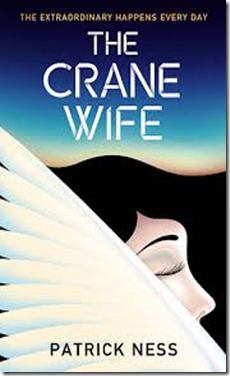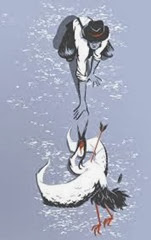George was eight, and at eight the definition of normal is whatever is happening in front of you. – Patrick Ness, The Crane Wife
As I was going through this book I highlighted only a single passage:
Stories do not explain. They seem to, but all they provide is a starting point. A story never ends at the end. There is always after. And even within itself, even by saying that this version is the right one, it suggests other versions, versions that exist in parallel. No, a story is not an explanation, it is a net, a net through which the truth flows. The net catches some of the truth, but not all, never all, only enough so that we can live with the extraordinary without it killing us.
It’s an important passage. The book, as did another I read recently, reminded me of The Owl Service by Alan Garner. In Garner’s novel an old story is being constantly re-enacted (a story from the Welsh Mabinogion, specifically portions of the story of Math) and that’s pretty much what we have in The Crane Wife, a reliving of the Japanese folktale, ‘Tsuru no Ongaeshi’ (lit. crane's return of a favour):
There are only (arguably) only seven plots but look how many variations of those exist! Stories, of course, are lies and fibbing is generally frowned upon in the real world but for some reason writers can get away with it again and again. The truth—the facts, if you like—is not important because the reader decides what any book’s truth is for him or her. In The Crane Wife, for example, George tells us about a car accident when he was eight-year-old boy living in America:
When George told this part of the story, he invariably found himself saying ‘This actually happened’ and ‘I’m not making this up’ because it seemed too cruel that the car that had run the red light and knocked into Roy and the bike and him should have been driven by an eighty-three-year-old lady who could barely see over the steering wheel.
Sadly, it was the truth. If George had ever learned her name, he’d long forgotten it, but he’d remembered that she was eighty-three, that she was barely taller than him or Roy, and that the words she kept repeating afterwards were, ‘Please don’t sue me. Please don’t sue me.’ For the dignity of old ladies everywhere, George often wished this part of the story hadn’t happened, but there you were, sometimes life didn’t oblige with appropriate variation.
He relates the story as he remembers it, from his perspective, having no other, but what he’s come to realise as he’s grown up is that that’s not the only version of the story available. He has his version of events. Everyone who was there on that day will have their equally valid version:
Did it matter? George thought perhaps it did, and not in terms of finding the truth or of any hope of discovering what really happened at any given moment. There were as many truths – overlapping, stewed together – as there were tellers. The truth mattered less than the story’s life. A story forgotten died. A story remembered not only lived, but grew.
Many years later in a garden in England George is provided with an opportunity to enter someone else’s story. It’s an old story (see the Wikipedia entry) but it gets replayed centuries later as always a little differently but at its core it remains the same. It begins in exactly the same manner as the original: a crane appears in his garden in need of assistance:
[T]here it stood. Alone in the middle of the modest stretch of grass that made up the modest back garden of his modest detached home.
A great white bird, as tall as he was, taller, willowy as a reed.
A reed made of stars, he thought.
Then, ‘A reed made of stars’? Where the hell did that come from?
The bird was illuminated only by the moon in the cold, clear winter sky, shades of white, grey and dark against the shadows of his lawn standing there regarding him, its eye a small, golden glint of blinking wet, level with his own, its body as long as he’d been when he was at his teenage gangliest. It looked somehow, he stupidly thought, as if it was on the verge of speaking, as if it would open its pointed, clipped bill and tell him something of vital importance that could only be learnt in a dream and forgotten on the instant of waking.
The bird’s been injured, shot through with an arrow, which George extracts from its wing somehow and the next thing he knows it’s flown off into the night.
Ness’s method of storytelling is an interesting one—he jumps back and forth in time and changes perspective (when George’s daughter appeared immediately after Kumiko wanders into George’s shop I wondered what the hell was happening) but it’s a good way to hold the reader’s attention and to help him reassess what he thought he understood. At one point, for example, there’s a fire and Ness provides five different ways in which the fire could’ve started. My assumption is that the last one was what really happened but it doesn’t really matter; in alternate realities any of the five could’ve happened and the result would’ve been the same. I wrote in a poem once that I didn’t believe in destiny but I did in inevitability. I think that’s what we have a case of here: the set-up is similar, the people are similar and so the outcome will be similar. Close enough for government work as my wife is fond of saying.
One of the problems with folktales is that the characters are archetypes and there’s not much depth to them. Well art found its third dimension—just think of how flat the cave drawings were and even the clever Egyptians’ art still had no depth—and the same has happened with literature. We regard folk stories and fairy tales as primitive forms of storytelling. Nowadays we want character development. Just look at the recent films based on fairy tales. Bad though many of them have been they’re on the right track. And so is this book. George, his daughter, his grandson, their friends, families and exes are all real. The only really two-dimensional character is Kumiko. Because she’s straight out of a story. Not so different to Arnold Schwarzenegger bursting off the screen in Last Action Hero.
That Kumiko is the embodiment of the crane George rescues at the start of the book is no big surprise. That she might come with baggage was. Granted her back story is a folktale but it’s still her back story, a love affair with a volcano of all things. Of course the real world ending explains everything away as hallucinations; they’re easier to cope with than the fact magic might exist.
George is a nice guy. Literature is full of nice, decent blokes, the Arthur Dents of this world, who get caught up in extraordinary events and just get on with it in a very British sort of way (even if, as is the case here, they’re not actually British). They’re also really annoying. Not that George is perfect—we learn enough along the way to realise that George is human—but (and I recall this being true of the comedian Tony Hancock) people forgive him rather too easily. George’s assistant expresses this perfectly when he says:
‘It’s because you inspire loyalty. No one wants to let you down. Which, frankly, makes them all vaguely irritated with you most of the time – I know it does me – but they stick around because they want to be sure you’re all right.’ Mehmet shrugged. ‘You’re likeable. And if you like them, well, that means they’re really worth liking, doesn’t it?’
I think I might’ve liked George if he’d been just a bit more flawed. In that respect his foul-mouthed daughter is a far better character.
Not a hard read by any means but very much a story. You want to get to the end, you want to see what happens to everyone but if you forgot to read a couple of paragraphs on a page then you didn’t feel like you were missing anything really important. To dismiss the book as a beach read would be to do it a disservice; it’s better than that, but it could’ve been even better. I came away from it dissatisfied. It reminded me of numerous Star Trek episodes where a guest star appears to play someone’s love interest and they do fall in love, big time but for some mysterious reason they can’t be together. That always bugged the hell out of me. And the same here. There was no reason why things had to end the way they did. Stories can change. Romeo and Juliet don’t have to commit suicide at the end of the play.
***
 Patrick Ness was born on Fort Belvoir army base, near Alexandria, Virginia in the United States where his father was a drill sergeant in the US Army. He then moved to Hawaii where he lived until he was six, then spent the next ten years in Washington State before moving to Los Angeles where he studied English Literature at the University of Southern California.
Patrick Ness was born on Fort Belvoir army base, near Alexandria, Virginia in the United States where his father was a drill sergeant in the US Army. He then moved to Hawaii where he lived until he was six, then spent the next ten years in Washington State before moving to Los Angeles where he studied English Literature at the University of Southern California.
After graduating he worked as corporate writer for a cable company. He published his first story in Genre magazine in 1997 and was working on his first novel when he moved to London in 1999. Since then he’s published three children’s books, two adult novels and a collection of short stories. The Knife of Never Letting Go, his first novel for children, won numerous awards, including the Booktrust Teenage Prize, the Guardian Award, and the 2008 James Tiptree, Jr. Award. In January 2010 he won the 2009 Costa Book Award for the category children's book for The Ask and the Answer. Monsters of Men won the CILIP Carnegie Medal and was shortlisted for the 2011 Arthur C. Clarke Award.
He taught creative writing at Oxford University and has written and reviewed for The Daily Telegraph, The Times Literary Supplement, The Sunday Telegraph and The Guardian.
He has been a Fellow of the Royal Literary Fund and is currently first Writer in Residence for Booktrust.






No comments:
Post a Comment